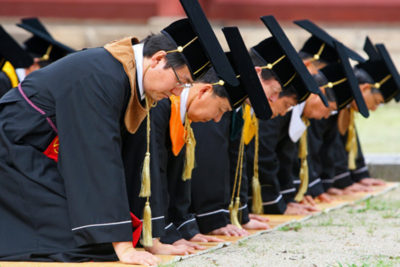
By Haddon Libby
The Paris-based Organization for Economic Co-operation and Development (OECD) mission is to promote policies that improve the economic and social well-being of people around the world. One of the things that this thirty-six member organization does is study educational trends.
When we look at 25-34 year-old adults globally, the most educated populace resides in South Korean where in 7 in 10 have attended college. Canada and Japan are next at 60% followed by Lithuania (55%), the United Kingdom (52%), Luxembourg and Australia (49%). Back here in Amurika, 48% of us have at least a little higher edumication. Mexico had the lowest levels at 22% followed by Italy (25%), Colombia (28%) and Costa Rica (29%).
What makes South Korea most interesting is that only 20% of 55-64 year-old South Koreans have college educations. To have education levels jump by 3.5 times in twenty years shows that their citizenry have made it a priority to increase knowledge in pursuit of better lifestyles.
Poland had the next highest jump from 14% for 55-64 year-olds to 44% for 25-34 year olds. Other notable jumps occurred in Turkey, the Czech and Slovak Republics and Portugal.
 While all countries studied showed increased education levels amongst their youngest, Finland had the lowest improvement as 25-34 year-olds at 41% were only 4% better than their 55-64 year-old counterparts. Similarly, the United States (48%), Estonia (41%) and Germany (30%) showed the weakest improvement.
While all countries studied showed increased education levels amongst their youngest, Finland had the lowest improvement as 25-34 year-olds at 41% were only 4% better than their 55-64 year-old counterparts. Similarly, the United States (48%), Estonia (41%) and Germany (30%) showed the weakest improvement.
Russia was found to have the highest college graduation rate at 85% followed by Australia (76%), New Zealand (75%), Japan (72%) and Denmark (65%). Other notables include the United States (55%), the U.K. (44%), Germany (39%) and Mexico (26%).
To better understand the meaning of these statistics, consider Mexico. One-quarter of the 22% of Mexicans who attended university will graduate. Stated differently, 6% of Mexicans graduate from college. Here in the United States one in four graduates. Korea does not report this number.
Overall, the OECD found that adults with a college education earned 56% more than their less educated counterparts while experiencing lower unemployment rates and a lower chance of depression. The OECD also found that 15% of all 18-24 year-olds did not work and/or were not pursuing a higher education.
For those pursuing a higher education, the most popular degrees were in business and law at 23% of enrollees followed by science, technology, engineering and mathematics (STEM) at 22%. Doctorates were more often STEM-related with the natural sciences and mathematics representing the most sought after Ph.D. Within STEM, engineering is the most popular undergraduate degree.
Primary education is generally considered Kindergarten through 6th grade. On average, 6% of the people of any country do not have a primary education. Of countries reporting, India has the largest percentage of uneducated people at 46% followed by Indonesia (43%), Portugal (30%), Costa Rica (29%) and China (25%).
Secondary education is generally considered junior high school and high school. On average, 16% of the people of any country do not have a high school education. China and India are tied with the highest levels of people without a high school education at 64% followed by Indonesia and Mexico at 53%.
When we look at colleges globally, it should be no surprise that the United States has the highest average cost per year at $21,189. Latvia is second at $12,000 followed by the United Kingdom at $11,750. College is free in many countries such as Estonia, Finland, Norway and Sweden. For those countries, their people and governments realize that a well-educated workforce earns the most which leads to the strongest and most robust of economies.
Haddon Libby is the Founder and Managing Partner of Winslow Drake Investment Management and can be reached at HLibby@WinslowDrake.com. For more information, please visit www.WinslowDrake.com.











































